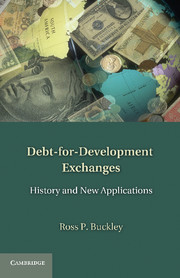Book contents
- Frontmatter
- Contents
- Acknowledgments
- List of Contributors
- Introduction: A Productive Partnership between Civil Society and the Academy
- Part I Types of Exchanges and Their Development over Time
- Part II Exchanges by Donor Countries
- Part III Critiques of Exchanges
- Part IV Innovative Applications of Exchanges
- 15 Farmer-Managed Natural Regeneration: A Land Rehabilitation Technique Well Adapted to Funding by Exchanges
- 16 Restoring Mangroves in the Philippines
- 17 Poverty Reduction through Social Protection: A Potential Form of Debt-for-Development Exchange
- 18 Climate Change Adaptation Exchanges: An Exploration of the Possibilities and Risks
- 19 Climate Change and Food Security: Building Resilience by Means of Climate Field Schools
- 20 Debt-for-Security Exchanges
- 21 Promoting Good Governance through ICT Systems: Improving Transparency and Reducing Corruption
- 22 Using Debt Exchanges to Enhance Public Accountability to Citizens
- Conclusion
- Index
- References
17 - Poverty Reduction through Social Protection: A Potential Form of Debt-for-Development Exchange
Published online by Cambridge University Press: 01 June 2011
- Frontmatter
- Contents
- Acknowledgments
- List of Contributors
- Introduction: A Productive Partnership between Civil Society and the Academy
- Part I Types of Exchanges and Their Development over Time
- Part II Exchanges by Donor Countries
- Part III Critiques of Exchanges
- Part IV Innovative Applications of Exchanges
- 15 Farmer-Managed Natural Regeneration: A Land Rehabilitation Technique Well Adapted to Funding by Exchanges
- 16 Restoring Mangroves in the Philippines
- 17 Poverty Reduction through Social Protection: A Potential Form of Debt-for-Development Exchange
- 18 Climate Change Adaptation Exchanges: An Exploration of the Possibilities and Risks
- 19 Climate Change and Food Security: Building Resilience by Means of Climate Field Schools
- 20 Debt-for-Security Exchanges
- 21 Promoting Good Governance through ICT Systems: Improving Transparency and Reducing Corruption
- 22 Using Debt Exchanges to Enhance Public Accountability to Citizens
- Conclusion
- Index
- References
Summary
In June 2000 the 23rd Special Session of the UN General Assembly agreed to set a global goal for poverty reduction of halving severe poverty by 2015, the first time a global target for poverty reduction had been adopted by a global conference. Three months later, this target was reiterated by the UN Millennium Summit, and in 2001 the goal of reducing extreme poverty to half its 1990 level by 2015 became the first of the Millennium Development Goals (MDGs). Most countries adopted the MDGs quickly; others were more reluctant, amongst them the governments at the time of the United States and Australia. However, with changes of government, they too have joined the rest of UN member states, so that now nearly all countries and international institutions are committed to the goal.
The World Bank projects that the proportion of the total population of developing countries living on US$1.25 a day or less (which has been used as the standard measure of severe poverty since 2008) in 2015 is likely to be 15%, considerably less than half the proportion in 1990 of 42%. This would mean that about 920 million people would be living under the international poverty line in 2015, about half the number in 1990. This dramatic improvement is principally because of the estimated fall in poverty in China, but declines are also under way in other East Asian countries, in Latin America and the Caribbean and in South Asia.
- Type
- Chapter
- Information
- Debt-for-Development ExchangesHistory and New Applications, pp. 209 - 222Publisher: Cambridge University PressPrint publication year: 2011



